
|   |

|   |
Krishna Bharatham - Lalitha Venkat e-mail: lalvenkat@yahoo.com Photos: Yoga August 23, 2016 Since 1997, Natyarangam, the dance wing of Narada Gana Sabha, has presented a thematic festival every year in Aug/Sept at the Narada Gana Sabha auditorium in Chennai. This year’s theme Krishna Bharatham (Aug 12 – 18) explored the various incarnations of Krishna through a presentation of the visionary works of great poets and composers, danced by a duo. As the resource persons are eminent scholars and experts from various disciplines, their enlightening talks on the evening’s theme before the commencing of the dance program, is usually a highlight in itself.  L to R: N Gopalaswami, Saroja Vaidyanathan, Medha Hari, Praveen Kumar, M Balachander, Charukesi, PC Ramakrishna On August 12, 2016 on the inaugural evening of the festival, the following artistes were awarded - Obul Reddy Endowment Award to Bharatanatyam dancer P Praveen Kumar from Bangalore, Sudharani Raghupathy Endowment Award to mridangam artiste M Balachander, Vasanthalakshmi Narasimhachari Endowment Award for talent promotion to Bharatanatyam dancer Medha Hari. Delhi based senior Guru Saroja Vaidyanathan was honored with a purse and medal.  Tanjore painting This was followed by a delightful, but rather long talk by Dr. Sudha Seshayyan on the different facets of Krishna as experienced by the Alwars (saint poets). Uniquely, all the 12 Alwars have sung something about Krishna. The Alwars not only sang about Krishna but lived his life. Kulasekhara Alwar felt close to Rama for several reasons, one being that both were born under Punarpoosam star. He transformed himself and sang as Devaki. For Andal, Krishna was everything, from the child in Vrindavan to the love of her life. Andal would rejoice in envisioning her merging with her lord. Thirumangai Alwar considered himself a parakala nayaki in his adoration of the lord. Periyalwar as Yashoda brought up Krishna. Unfortunately, the power point presentation did not work out. 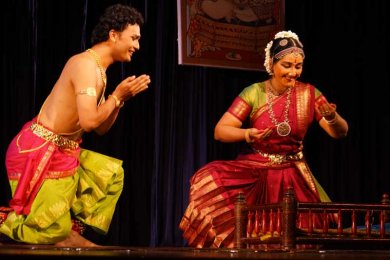 Uttiya Barua & Radhika Vairavelavan Radhika Vairavelavan and Uttiya Barua presented the different stages of the growing Krishna from the cradle to the butter eating episodes, lifting the Govardhana mountain, Garuda’s wings providing shade for the young Krishna when he’s tending to his cows, Andal kalyanam and finally a thillana. The light effect to denote Krishna’s parents behind prison bars is worth mentioning. Sasirekha Rammohan (nattuvangam), Jyotishmathi Sheejith (vocal), Vedakrishnaram (mridangam), Sruti Sagar (flute) and Jaya Shekar (veena) provided music support. Uttiya Barua shares his experience. “As a Bengali, Alwar was a new word for me and on Radhika’s advice, I got a book Nalayira Divyaprabandham and started reading the translation. But from where to where should I read? Radhika and Dr. Sudha Seshayyan helped me to sort it out. Then we took help from Dr. Raghuraman, put together our own ideas, Dr. Vanathy Raghuraman gave us the music and we started choreography. But so many ragas were new and the literature was very heavy for my understanding. Again we got help from Raghuraman sir for better understanding but now was the main challenge - choreography. Radhika loves to play with rhythm whereas as a Bengali, I am more into drama element, but within a few days we understood each other and our natya and natakam blended. Thanks to the challenging topic, I have learnt beautiful literature, new ragas and unusual jathis. And I have seen Lord Krishna from a different view point.” 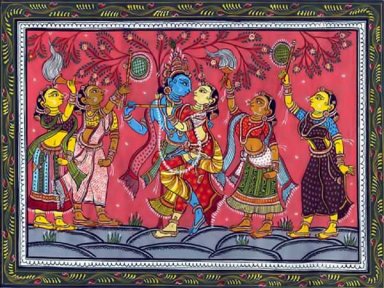 Patachitra The ‘technical glitch’ again on the second day resulted in almost a half hour being wasted while we got to see a silent film of resource person Dr. Pappu Venugopal Rao talking about the Geeta Govindam (since he was away in Manasarovar!). When it did start working, it was in fits and starts and it finally conked out after a few minutes. In those few minutes, we learnt that Jayadeva was the foremost composer in both Carnatic and Hindustani. He composed in Sanskrit and even in that, he created his own style. He wrote only 24 songs but they are so popular that all major dance styles include a Jayadeva ashtapadi in a presentation. The uniqueness of Geeta Govindam is that, Radha was an obscure character until Jayadeva made her the heroine. 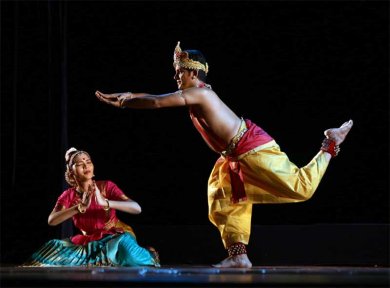 Shabana & BK Shafeekuddin BK Shafeekuddin and his dancer wife Shabana presented a well conceived and coordinated sequence of slokas, ashtapadis and events from Jayadeva’s life. There was never a dull moment. Starting with a brief shloka “Meghair meduram,” a pushpanjali set by Vanathy Raghuraman, an invocation to Vasudeva was followed by “Srita Kamala” performed behind a tirasheela. The first ashtapadi “Pralaya payodi jale” was about the 10 incarnations where Krishna is not an avatar but he’s supposed to be the one who has taken these avatars. “Lalita lavanga lata,” “Chandana charchita,” “Mamiyam chalita,” “Nindati chandanam,” “Yahi Madhava,” “Priye Charusheele” and “Kuru yadu Nandana” were some of the ashtapadis the duo performed to. The sakhi shows Radha that Krishna is also playing around with the gopis, Radha gets angry, sakhi conveys that to Krishna, a repentful Krishna approaches Radha, but she spurns him much to his anguish, sakhi then conveys Krishna’s anguish at the separation to Radha. Charmingly depicted was the short story of how when Jayadeva has gone for his bath, Krishna disguised as Jayadeva, himself wrote the lyrics “dehi pada pallavamudaaram” (Krishna bows down his head to the lotus feet of Radha) on the palm leaves in Padmavati’s presence, takes the prasadam prepared by her, steps outside and vanishes. When Jayadeva returns from his bath, he sees the finished line and is ecstatic that Krishna has indeed blessed him by penning what he himself had been wanting to. Radha finally relents and the pair glows in their love for each other, smoothly moving into the concluding thillana like piece on a joyous note. Jayashree Ramanathan (nattuvangam), Prashant Kaimal and Manoj (vocal), Guru Bharadwaj (mridangam), TK Padmanabhan (violin) and Sruti Sagar (flute) accompanied the dancers. A small Krishna idol was their only prop and Shafeekuddin made for a charming Krishna. “Actually we were given the program just a month before since the original artistes had dropped out. Someone was supposed to help us with the songs but for 2 weeks nothing happened. We managed to get the permission to use ashtapadis rendered by OS Arun, Guru CV Chandrasekhar and Bharata Kalanjali and evolved it into a story pattern. We worked every day till midnight as we had only 2 weeks to work on it. Also, there were no vocalists available as most of them were travelling overseas. We therefore had to use 2 vocalists because both of them are not trained to sing for dance. With all this, we managed to get through our presentation!” says Shafeekuddin. 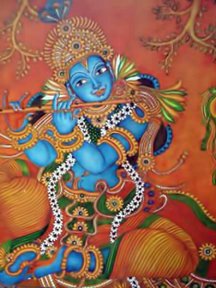 Kerala mural The third evening started off with an elderly lady falling along with her walking stick in front of the first row as the hall was totally dark for the evening’s announcements by PC Ramakrishna. Since the hall has no floor lights to guide a person, it is a great hazard for the many senior citizens who attend programs. It took about 20 minutes for the scare to subside and the poor lady to get up and walk over to a seat nearby. Resource person Kausalya Sivakumar then invited the audience to go on a trip of Krishna consciousness as envisioned by Leelasukar in Sri Krishna Karnamritam. The text is very dance friendly and by quoting the slokas you can see the jathis in them, and can visualize the dance take form in front of you, she said. In his younger days, Leelasukar (also known as Bilva Mangala) was besotted with a courtesan Chintamani. When she chided him to direct that devotion to the lord, Leelasukar, though a Saivite by birth, became a Krishna devotee. In his great Sanskrit work, Krishna is love, beauty, joy, divinity and sublime salvation but there is an undercurrent of danger lurking in his life. Krishna does not belong to anybody but is everything to everybody. If you smile at life, life will smile at you, is the message of Krishna Karnamritam. 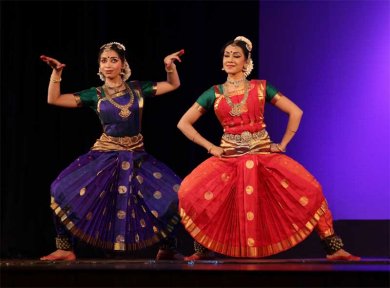 Apoorva Jayaraman & Swetha Prachande Swetha Prachande and Apoorva Jayaraman, both students of Priyadarsini Govind, presented a scintillating, beautifully coordinated and imaginatively choreographed presentation. They opened with the slokam “Karavindena” leading to a slokam composed in the form of a kautuvam describing Airavat, Nandi and Subramanya’s peacock admiring the dance of Krishna. Two young girls walk on the streets of Mathura wondering who the young, handsome boy was who walked like an elephant and had a peacock feather in his hair. The next piece was set in a varnam format describing the music from Krishna’s flute that melted mountains, benumbed animals and set the entire universe into a trance. Leelasukar conceives unique conversational situations, like one between a gopi and Krishna. When he’s caught stealing butter, he calls the gopi endearingly as “mother” and pretends to look for his lost cow in the butter pot! When Krishna comes knocking on Radha’s door, an interesting exchange ensues that annoys Krishna no end. “Who’s there?” asks Radha. “Madhava.” “Spring?”… “I’m the one who killed Kaliya.” “Garuda?” and so on. Expressive passages interspersed with vibrant nritta segments and excellent coordination between them made for an absorbing recital. The dancers ended with a bhajan amidst a backdrop of lit diyas, in Leelasukar’s words: “Even though he was a little boy he lifted a mountain, Even though he was blue in colour he dispelled darkness, Even though he was brave he was tied in Radha's loving glances, And even though he is known to be a little prankster he is the one who takes away all our troubles and protects us." The accompanying artistes were Jayashree Ramanathan (nattuvangam), Vasudha Ravi (vocal), G Vijayaraghavan (jathi composition and mridangam), Nandini (violin), Sruti Sagar (flute). Music composition was by Rajkumar Bharati. Shweta shares about the artistic process. “To address or to even begin working with a text like Krishna Karnamritam was overwhelming at first. My immediate reaction was to try and gather as much information as possible about the author Leelasukar, and his motivation to have composed this elaborate 3 part oeuvre. The text does not follow a chronological order per-se, but each slokam is written with great affection, reverence and a very imaginative vision of the life and episodes of young Krishna. There are so many varied situations, conversations and descriptions that the biggest challenge was to shortlist only a few slokams and to string them together in a format that would work for a dance presentation. Secondly, there was the constant effort to try and understand the meaning and subsequently interpret the essence of what the poet wished to express. It was a wonderful experience primarily because we had to begin from scratch on all fronts - concept, music, choreography, costume, light and design. The unique feature being there were two of us working together on the project and that made things very interesting and gave each idea multiple flavours and methods of execution. The entire journey from the inception of the project to the final presentation has been deeply fulfilling and at the same time has given me a keener understanding of my artistic identity and given me insight into the workings of a truly holistic creative process.” 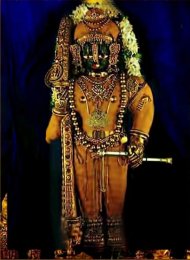 Udupi Krishna After lessons learnt, the hall lights were turned off only for the dance performance from the fourth evening onwards. Violinist RK Shriramkumar, who has composed for dance productions too, enlightened the audience about the Dasa parampara, the stalwarts of the bhakti movement that played an important role in our cultural history. It inspired the people of all castes and communities to engage in pursuit of the divine as the philosophy was imparted in simple, understandable language. The Haridasas followed Madhavacharya, who followed the dvaita philosophy. They used music to propagate their views. The 5 most prominent Haridasas are Sripadaraya, Vadiraja, Vyasaraya, Purandaradasa and Kanakadasa. The Haridasas contributed significantly to literature and Carnatic music. Purandaradasa designed and codified the abhyasa lessons in Carnatic music. 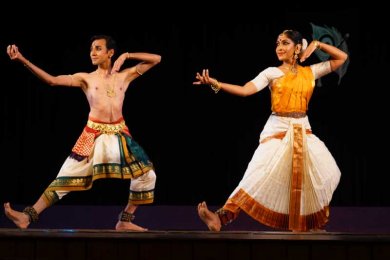 P Praveen Kumar & Jyotsna Jagannathan Jyotsna Jagannathan and P Praveen Kumar (a last minute replacement) commenced with a duet for Dwadasha stotram and from then on, they performed solos for the various bhakti songs with one entering the stage and the other exiting with a scene together linking the items to give a sense of continuity. Praveen added interest with minor costume changes to portray Purandaradasa, Kanakadasa and Krishna. His depiction of Kanakadasa’s “Bagilanu theredu,” the story of Kanakadasa (of the shepherd community) where he’s not allowed into the Udupi temple and the idol itself turns around for him was well portrayed to great appreciation from the audience. Some of the bhajans included Purandaradasa’s “Chikkavane ivanu,” “ninyako” and “Maneolagado Govinda,” verse from “Jagadodharana,” “Brindavanadolu aaduvanu yaare” and “That thaka dimithat adithane.” Linking the items together was the refrain from “Krishna nee begane” to portray the feelings of a mother/father, a lover, a devotee. Srilatha on nattuvangam, K Hariprasad on vocal, Srilakshmi Venkatramani on violin, G Vijayaraghavan on mridangam and Sruti Sagar on flute enhanced the presentation. Music was composed by Hariprasad and DS Srivatsa. Jyotsna Jagannathan talks about her experience. “Working with the Dasar poetry seemed to be within comfort zone at the outset because the devarnamas have been used widely in dance choreography. Having said that, we did however have to delve into the works of some of the less popular poets as well. The songs are all of condensed expression and brevity without in-depth account and to keep to the ethos, we had to choreograph on the same lines. We found that the poetry was deeply shaded with bhakti and all narratives or emotions were circumstantial. The way they visualised Krishna fell very easily and clearly into seeing him as a Mystical Child or as the Ultimate Saviour. We struggled to find some poetry that was in the genre of sringara or that visualised him as the Divine Lover- the songs were more descriptive of his form, beauty and quality...The Child Krishna and the Lord were much easier to weave into story but we needed to take artistic liberty with the Divine Lover - we used the metaphor of the bee and the lotus to deepen the hues of love. “Krishna nee begane baro” was what we decided to begin with but as the piece unfolded it became more obvious as the ideal way to link the three part production. We had a great team of musicians who worked with trying to ensure that the essence of the Haridasas’s songs would come through. Being a soloist and working with another soloist always means a difference of aesthetics and dance imagination and creativity so there were compromises from both dancers on how each song or idea should be approached but again a huge learning! Sometimes it’s about being more certain of your conviction and sometimes it was about re-questioning it. But the biggest challenge was most definitely to convert all duet choreography into solo work in a week!” 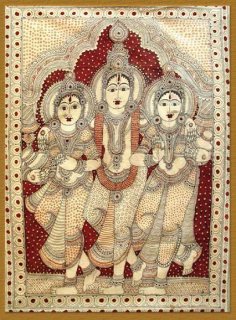 Kalamkari painting Bharatanatyam vocalist and Harikatha artiste Girija Ramaswamy waxed eloquent on 17th century Andhra composer Narayana Teertha’s Krishna Leela Tarangini (the river of Krishna’s leela) on day five of the festival. Teertha was a great scholar in Sanskrit and music. He followed Veda Vyasa’s Bhagavatam and concentrated on the 10th skandam. This opera that is suitable for dance drama is the lengthiest musical play in chaste Sanskrit and comprises 12 chapters. It is about the life story of Krishna starting with his birth, childhood pranks and ends with his marriage to Rukmini. 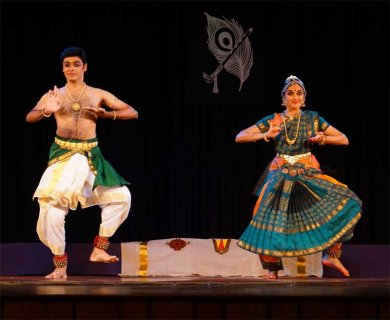 Girish Madhu & Anjana Anand The artistes Anjana Anand, who impressed with her abhinaya skills, and Girish Madhu presented select excerpts in five segments including the glory of Krishna as the ultimate god, how Rama Krishna Govinda can be uttered at any time anywhere, “Jaya jaya Ramanatha,” “Yehi mudam dehi,” “Pashyata pashyata Bhagavantam,” some lesser known incidents of Krishna vanquishing different asuras like the fire asura and Kamsa’s wrestler Chanura. The pining of gopis in sringara rasa was followed by the incidents leading to Rukmini’s marriage with Krishna, ending the presentation with a mangalam. The accompanying artistes were Sheejith Krishna (nattuvangam), Jyotishmati and Jaminish (vocal), Guru Bharadwaj (mridangam), Nandini (violin) and Sruti Sagar (flute). “Girish Madhu and I presented select verses and songs, and wove in some incidents in Teertha's life where Krishna inspired him to compose music. The immediate challenge was to selecting the songs which were largely nama sankeertana type of compositions and present them in an interesting way, avoiding cliches of Krishna! When we went through the whole text we found that Krishna was visualized in many different ways...as a child, lover, God. We then divided our production into 5 parts highlighting Krishna as each of the above and finishing with Rukmini Kalyanam as requested by Natyarangam. The challenge was to keep the simplicity of the text while making it visually exciting,” says Anjana Anand. 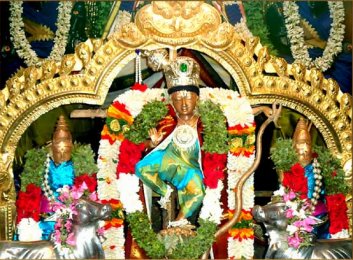 Kalinga Nartana Perumal The hall was filled to capacity for the talk by Chitravina Ravikiran (hailed as the “Mozart of Indian music”) on Oothukadu Venkata Kavi. Ravikiran called him an uthama vaggeyakara, one of incalculable brilliance merged with so much of inspired divine grace, scholarship, and erudite in almost every aspect of Indian culture. Though Devi was their family deity, Krishna became Venkata Kavi’s personal favourite. A composer himself, he gave beautiful touches by mentioning the raga in between the lyrics. Though Radha has never been a major figure in mainstream Carnatic music, Venkata Kavi has composed Radha Kalyanam apart from Rukmini Kalyanam. The most well known opera composed by him is ‘Krishna Ganam’ based on Bhagavatam, which narrates Krishna’s birth and colourful childhood, ending with his wedding to Rukmini. It is now well known that many popular songs on Krishna like Taye Yashoda, Alaippayude kanna, Pal vadiyum mukham, Parvai onre podume and Pullai piravi tara venum are part of this opera. He has also composed operas on Ramayana, Mahabharata, Dhruva Charitram, Prahlada Charitram etc, songs on other deities like Vinayaka, Tyagaraja of Tiruvarur, Kamakshi, Rama, Narasimha, Anjaneya, Ranganatha, Surya, on great sages like Shuka Brahma Rishi, Jayadeva and Valmiki, on Azhwars and Nayanmars, etc. As a person who has sighted the maximum number of historic personalities and eulogized them, one gets the clues as to the time period he lived in. Because of their dramatic appeal and creative content, Venkata Kavi's works are popular with dancers.  Medha Hari & Bhavajan Kumar Medha Hari along with Bhavajan Kumar gave a sparkling recital following a margam format, full of energy and poise, engaging expressions and firm footwork. They commenced with “Maragadha manimaya chela” (Arabhi/adi) singing praise of Gopala whose garment is as bright as the emerald gem, whose mesmerising beauty surpasses that of a crore Manmadhas. Virutham in Brindavana Saranga was followed by the varnam “Bala sarasa murali” (Keeravani/adi) in which he entices the whole universe with the music that comes from his flute. The peacock feather that he wears is his crown, the rock that he sits on in the forest is his throne, Radha is his queen and the women who melt in his love are the courtiers. Some padams on Krishna’s pranks included “Kaanerey” on Krishna’s obsession with butter and the extremes he takes to achieve it. “Ivan dhaan ivan dhaaney” and “Ippadiyum oru pillai” depicted his magical ways where he troubles the citizens of the Aayarpadi clan. In “Illai illai illai amma,” Krishna attempts to convince his mother that he is innocent and that the gopis are scheming against him. In “Pesadha pongaladi,” Yashoda tells gopis that they have gone mad and that her son is innocent. These delightfully emotive pieces rendered charmingly by the dancers were received with great enthusiasm by the audience, culminating in the vibrant Kalinga Nartana thillana. The recital ended with the oonjal song from Radha Kalyanam. The smoke machine was used on and off during the recital and one of them went whoosh with every puff. It also spread mist that made the stage slippery! The accompaniment was by Jayashree Ramanathan (nattuvangam), K Hariprasad (vocal), Vedakrishnaram (mridangam), K Vijayaraghavan (violin) and Sruti Sagar (flute). “Our experience with this project has been extremely gratifying. Although I had grown up listening to songs of Oothukadu Venkata Kavi, never did I actually take any initiative to get to know who he was and what his journey was like. I’m extremely grateful to Natyarangam for having given Medha and me this eye opening initiative. A few weeks before the show I even made a trip to Oothukadu which is a very small village; there I was very lucky to see Kalinga Nartana Perumal and the place in which Oothukadu Venkata Kavi lived (although a house does not exist anymore, they have planted a tree in the place as a memory). It was a very enriching visit that I will remember for the rest of my life. Some challenges we faced during the creative process: I had been travelling to North America so most of our choreography happened over skype and I wasn’t a believer of this technique but it worked tremendously well, the only difficulty was the difference in time zone. Both Medha and I have been trained in different schools so naturally our bodies were tuned differently. It was a great experience to exchange some interesting adavus from our respective schools throughout our choreographic sessions. But it took a great deal of rehearsing to achieve a level of synchronization. We faced a bit of trouble selecting our pieces because Venkata Kavi has composed an ocean of compositions, so it was very heartbreaking to leave a few songs that we really loved but we tried to cover various emotions in each piece so we chose what would bring out the best of his vision. The Kalinga Nartanam especially was tricky because it’s a much loved very popular number amongst dancers. Also the sahityam and jathis alternated making it a very different “thillana” or natangam as it is categorized. So choreography happened in about 3 days, we tried to make it our own and we hope we did it justice. Overall, we have had the utmost support from our gurus who were encouraging and supportive, who saw our choreography and gave whatever embellishments it needed. Without them we would not have been able to experience these compositions as we did,” says Bhavajan Kumar. 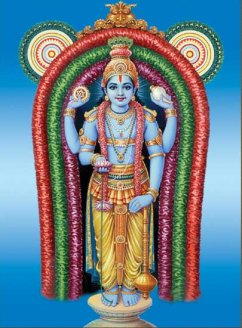 Guruvayurappan The final evening of the fest opened with a talk on Narayaneeyam by Damal S Ramakrishnan, who is known for his many religious discourses. He said that Narayaneeya Sapthaham (the recitation) is conducted in Guruvayur temple (where he is worshipped as Guruvayurappan) for seven consecutive days and coincidentally, it was the theme for the seventh day of the fest. Melpathur Narayana Bhattathri, a celebrated Sanskrit poet of Kerala, condensed the 18000 verses of Bhagavatam into 1036 verses of Narayaneeyam when he was but 27 years old. It is written in first person as a direct conversation with Lord Guruvayurappan. 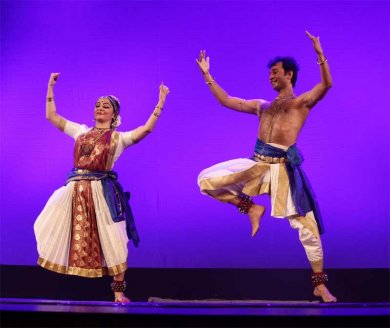 Parvathy Menon & Shijith Nambiar Shijith Nambiar and Parvathy Menon’s presentation on the life of Bhattathri and excerpts from Narayaneeyam was imaginatively choreographed and beautifully presented. The program started off with the sounds of the pancha vadyam like in a temple. Description of Guruvayur temple with daily pooja and description of Lord Guruvayurappan, raas kreeda of Krishna and Gopis of Vrindavan, Mathura pravesham, was followed by the Kuchela episode well portrayed by Shijith. The raas item by the husband-wife duo imbued with a flirtatious mood was delightful and charming. The Krishna story was interspersed with segments about Bhattathri’s own life. When Narayana Bhattathri’s guru Achutha Pisharodi is afflicted with paralysis and is in pain, as guru dakshina, he prays to the lord to transfer the disease to himself. Lord Krishna granted Bhattathri his wish, and he soon became crippled. When Bhattathri was carried into the Guruvayur temple, he met eminent Malayalam poet Tunchath Ezhuthachan, who advised Bhattathri that he could be cured if he “began his treatment with fish.” Bhattathiri understood that as a hymn glorifying the incarnations of Lord Krishna beginning with the Matsya avataram. The lord tells him that after the hundredth day of his composing, as he started describing the lord’s features, his own body would get healed accordingly. In deep devotion, Bhattathri composed and rendered one dashakam (canto) each day to the lord. Thus, in 100 days of sincere worship, Narayaneeyam consisting of 100 dashakam was composed. Blessed by the lord with viswarupa darshan on the 100th day, Bhattathri gives a vivid description of the lord’s enchanting form. From that day his ailments vanished and he got totally cured. This story was enacted with Parvathy playing Bhattathri’s role, and the final scene where Shijith as the lord shows his viswarupam was dramatic. The poet is also fully recovered and the evening ended on a positive note! Music by Rajkumar Bharati was evocative. Musicians Uday Shankar Lal (nattuvangam), Jaminish (vocal), Nandini (violin), Ganapati (tabla), Guru Bharadwaj (mridangam) and Sruti Sagar (flute) elevated the performance with their expertise. “Choosing the verses was the biggest challenge. The Narayaneeyam is a vast ocean of rich literature. Developing it into a one and a half hour performance was very tough. We were asked to have the raas kreeda as our main piece. Raas kreeda is full of shringara and to depict it in a very subtle and aesthetic way was another challenge. Instead of portraying various stories of Krishna one after the other, we chose to have the poet himself visualising the leelas and conversing with the lord in his dream,” says Parvathy. Why did they not use Kerala music for the production? “Last year when we were given the Travancore Kings as the topic, we used a lot of sopana sangeetham and we didn't want to repeat it. Normally in Kerala, sopana sangeetham is used for ashtapadis and Kathakali padams. Also, we didn't do any slow padams where we could have used that kind of music.” All the dancers in the festival wore aesthetically designed costumes in pleasing color combinations. Sruti Sagar was the flute playing Krishna on all the seven days! A single peacock feather and flute by artist Bala formed the only décor in the backdrop. To the side, a painting in a different style signified the presentation of the day. Most of the resource persons spoke well beyond their assigned time limit. What could have been avoided was the reading of long bios of the performers. Is it necessary to know how many languages an artiste speaks or an exhaustive list of his/her performances! Not only the dancers, but the team behind the festival had its own dress coordination! Says Janaki Srinivasan, “We always like to dress to suit the theme - that’s what we have been doing over the years. We choose the colours of our saris, designs, etc. accordingly. For eg. For different kshetras we wore saris belonging to that region or suited to the deity. During Teertha Bharatham we wore the colours of that particular river - red to suit Brahmaputra called the Red River, etc. When the themes are too complicated to find suitable saris, we go by the colour of the days of the week. This year for Krishna Bharatham we decided to bring out all our blue saris in celebration of Krishna - the Blue God! Except on 15th August when we wore white for our Independence Day + It was conveniently a Monday (moon day) too. To bring about some uniformity in variety the borders this year denoted the colour of the day. For example, Tuesday - Blue with any shade of red border, Wed - Blues with green border, Thurs - blue with yellow border, Sat - Blue & black combos; Sun - Saris with blue, orange, pink or multicolour checks. And of course, we wore a real peacock feather pinned on as a brooch!” Lalitha Venkat is the content editor of narthaki.com |